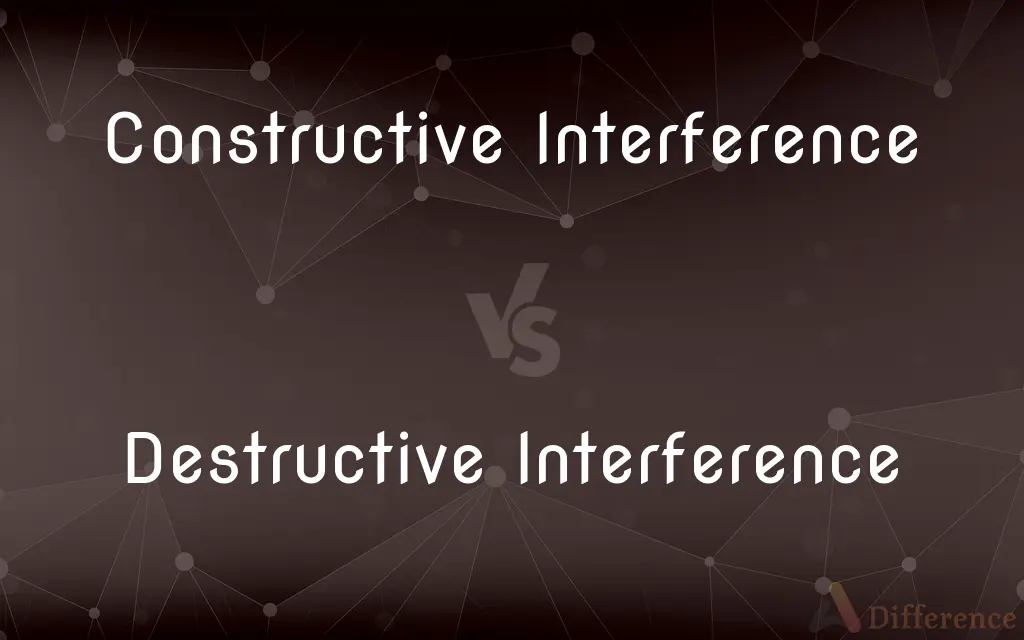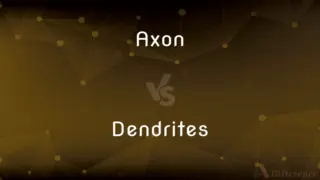Constructive Interference vs. Destructive Interference — What's the Difference?
By Fiza Rafique & Maham Liaqat — Published on October 10, 2024
Constructive interference occurs when waves align to increase amplitude, whereas destructive interference results in reduced amplitude.

Difference Between Constructive Interference and Destructive Interference
Table of Contents
ADVERTISEMENT
Key Differences
Constructive interference happens when two or more wave crests (or troughs) meet and combine to produce a wave of greater amplitude, leading to a stronger signal. This phenomenon is often observed in sound waves, light waves, and water waves, where waves in phase amplify each other. Destructive interference, on the other hand, occurs when a crest of one wave meets a trough of another, causing them to cancel out or reduce each other's amplitude. This can result in a weaker signal or even complete cancellation if the waves are of equal amplitude but opposite phase.
In constructive interference, the phase difference between the waves is an integral multiple of 2π radians (0, 2π, 4π, etc.), which means the waves are in phase and reinforce each other. In destructive interference, the phase difference is an odd multiple of π radians (π, 3π, 5π, etc.), indicating the waves are out of phase and cancel each other out. This phase difference is crucial in determining the type of interference that occurs when waves intersect.
Constructive interference can lead to phenomena such as resonance, where an object vibrates at a natural frequency and, when driven by a matching frequency, results in amplified motion. This is seen in musical instruments and architectural structures. Destructive interference is used in noise-canceling headphones, where sound waves with the opposite phase to ambient noise are created, effectively reducing the noise level.
In practical applications, constructive interference is utilized in areas such as radio and television broadcasting, where signals from multiple transmitters can strengthen the overall signal in certain areas. Destructive interference is applied in technologies like active noise control in cars and industrial machinery, where unwanted sounds are minimized through phase-opposite sound waves.
Both types of interference demonstrate the wave nature of light in phenomena like the double-slit experiment, where constructive interference leads to bright fringes and destructive interference to dark fringes on a screen. This illustrates the principle of superposition, where the resultant wave at any point is the sum of the individual waves.
ADVERTISEMENT
Comparison Chart
Resultant Amplitude
Increased, leading to a stronger signal
Decreased or nullified, leading to a weaker or no signal
Phase Relationship
Waves are in phase (0, 2π, 4π...)
Waves are out of phase (π, 3π, 5π...)
Applications
Amplifying signals, resonance in musical instruments
Noise cancellation, active noise control
Example Phenomena
Resonance, bright fringes in the double-slit experiment
Noise-canceling headphones, dark fringes in the double-slit experiment
Practical Use
Radio, television broadcasting, optics
Acoustic engineering, architectural acoustics
Compare with Definitions
Constructive Interference
Phase alignment
Constructive interference occurs when sound waves from two speakers align perfectly.
Destructive Interference
Noise cancellation
Destructive interference is employed in quieting car engines.
Constructive Interference
Amplitude increase
In constructive interference, two converging light waves can brighten a room.
Destructive Interference
Dark fringes
Dark bands in the double-slit experiment result from destructive interference.
Constructive Interference
Resonance
Constructive interference in a guitar string can amplify its sound.
Destructive Interference
Amplitude reduction
Destructive interference can cause two colliding water waves to flatten.
Constructive Interference
Signal strengthening
Radio signals can be boosted through constructive interference from multiple antennas.
Destructive Interference
Signal weakening
Destructive interference can disrupt communication signals when phases oppose.
Constructive Interference
Bright fringes
In the double-slit experiment, constructive interference produces bright light patterns.
Destructive Interference
Phase opposition
Noise-canceling headphones use destructive interference to silence ambient noise.
Common Curiosities
Can interference occur with all types of waves?
Yes, interference can occur with any type of waves, including sound, light, and water waves.
How do noise-canceling headphones utilize destructive interference?
They generate sound waves that are the exact opposite (phase) of ambient noise, canceling it out.
What causes interference in waves?
Interference occurs when two or more waves overlap, combining their amplitudes due to the superposition principle.
What role does phase play in interference?
The phase relationship between intersecting waves determines whether interference is constructive or destructive.
Can destructive interference completely cancel out a wave?
Yes, if two waves of equal amplitude and opposite phase intersect, they can completely cancel each other.
How does the double-slit experiment demonstrate interference?
It shows constructive interference as bright fringes and destructive interference as dark fringes on a screen.
Are interference effects always desirable?
Not always; while they can be useful in applications like broadcasting, they can also cause signal disruption.
Is interference a permanent effect on waves?
No, interference is a localized effect; waves continue to propagate independently after they intersect.
How is constructive interference used in broadcasting?
Broadcasting utilizes constructive interference from multiple transmitters to strengthen signals in certain areas.
Can constructive interference increase sound volume?
Yes, when sound waves constructively interfere, they can increase the volume of the resultant sound.
Can interference patterns be predicted?
Yes, using the principles of wave physics, interference patterns can be mathematically predicted.
What is the principle of superposition?
It states that the resultant wave at any point is the sum of the individual waves at that point.
How do waves remain independent after interference?
Waves do not permanently alter each other; they simply superpose at the point of intersection and continue unaffected.
What is an example of interference in everyday life?
Interference can be seen in the colorful patterns of an oil slick on water, where light waves interfere.
Can interference be controlled in scientific experiments?
Yes, by carefully controlling the phase and amplitude of waves, interference can be manipulated for desired outcomes.
Share Your Discovery

Previous Comparison
Acrylic vs. Plexiglass
Next Comparison
Axon vs. DendritesAuthor Spotlight
Written by
Fiza RafiqueFiza Rafique is a skilled content writer at AskDifference.com, where she meticulously refines and enhances written pieces. Drawing from her vast editorial expertise, Fiza ensures clarity, accuracy, and precision in every article. Passionate about language, she continually seeks to elevate the quality of content for readers worldwide.
Co-written by
Maham Liaqat










































